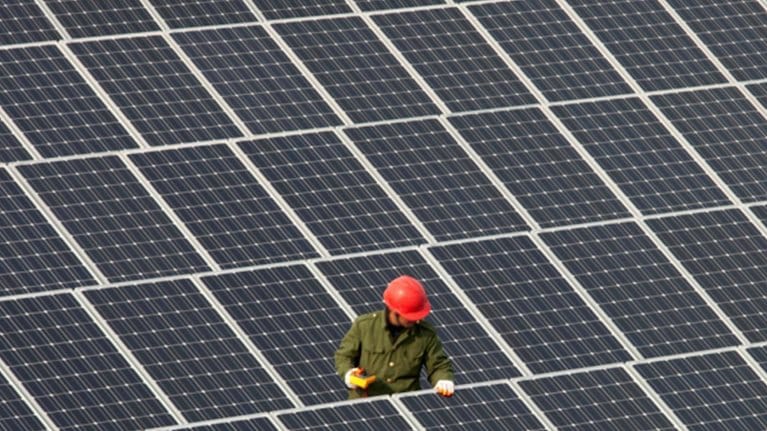Solar energy is becoming a force to be reckoned with.
Last year, China and the United States installed a record 15 and 7.5 gigawatts (GW) of solar, respectively. This year, the world could install as much as 66 GW.1 In 2015, investors poured $161 billion of capital into solar, the largest amount for any single power source.2 In China, 43 GW of capacity have been installed, more than in any other nation; India aspires to build 100 GW of solar capacity by 2022. Across the sun-drenched Middle East, investment rose from $160 million in 2010 to about $3.5 billion in 2015.3
The world is building more solar-power plants because they are getting cheaper. Since 2009, the total installed costs of solar have fallen by as much as 70 percent around the world. New power-purchase agreements frequently fall below $100 per megawatt-hour, with some reaching less than $30.4 That price puts solar at or below the cost of a new natural-gas plant.
Regulatory measures, such as the Investment Tax Credit in the United States, further support the economics of solar. In many instances, solar is often “in the money”—that is, less costly than the next cheapest alternative. A number of leading multinationals are signing solar deals not only to gain green credentials but also to lower their energy costs and diversify their sources of supply.
Given these trends, we believe that 2,000 to 3,000 GW of solar capacity—or almost half of total electric-power capacity in the world today—will be economic by 2025. Of course, solar can’t fully meet the need for electricity on its own because (among other reasons) the sun doesn’t always shine, so not all of this will be built. But a significant portion will. And that growth will transform energy markets around the world.5
Although the future is bright, many solar companies are struggling. Downstream providers—the developers and builders of solar-power plants—have pursued growth and market share but struggled to deliver profits. In the United States, valuations of some companies fell drastically in 2015 and 2016, and there have been a number of high-profile restructurings and bankruptcies, possibly with more to come.
Macro factors also play a role. Low oil and gas prices have tested solar’s competitive position. The threat—though perhaps now more distant—of higher interest rates is another negative factor because the economics of solar projects are sensitive to the cost of capital.
In spite of these issues, we believe opportunities for growth and profit exist throughout the solar value chain. To survive the current market conditions and prosper in the longer term, downstream businesses in particular need to overcome two major challenges.6
The challenge of project margins
As more companies enter the market for solar projects, competition intensifies—and profits narrow. The solar industry is relatively young, so construction costs vary widely, with some firms experiencing severe overruns. To maintain attractive margins, the best players will drive down the cost of building a plant faster than the industry average, allowing them to grow and take market share. To do so, they must address system design and construction execution.
System design. Systems for solar are typically designed from the bottom up. Each power plant or roof gets the perfect answer, a process that translates into high costs for labor and production. It doesn’t help that the solar supply chain is immature, and the technology itself is still evolving rapidly. Many of the sector’s engineering, procurement, and construction (EPC) companies are small, with limited solar-specific capabilities.
As the industry scales up, players should develop systems based on prefabricated components that are a very good, but not perfect, fit for a wide range of sites and that will integrate easily in the field—an approach known as “design for constructability.” In addition, automation and aerial site assessments can speed up design prototyping and help firms make more accurate estimates before they put boots on the ground (or the roof).
Would you like to learn more about our Sustainability & Resource Productivity Practice?
In the case of large utility-scale projects, better up-front assessments of ground conditions can minimize rework for pile driving or trenching. Developers could prefabricate off-the-shelf units, making it possible to install them in hours rather than days for rooftops, or in weeks instead of months for large ground-mounted systems. To achieve this goal, firms will have to overhaul their supply chains to ensure that components can work with one another and should collaborate closely with EPC companies to create and deploy cost-saving ideas. The automotive industry, which uses standard designs over and over for different models, is a helpful analogy. Similarly, big-box retailers often use a handful of standard designs for their stores.
Construction execution. Traditionally, construction performance has taken a back seat to project development. But from now on, as the industry scales up and the number of projects grows, solar companies must pay more attention to execution.
Many of them struggle to finish projects on time and on budget; the resulting delays and cost overruns damage profitability and capital management. Ultimately, projects are at risk if they miss deadlines for operations and for connections to the power grid.
Photovoltaic (PV) solar plants are not nearly as complex to build as other types of power plants. Even so, firms need contracting strategies that align their own incentives with those of their construction partners across the life of each project and that standardize execution in the field. Owners should be able to monitor progress and capture performance data to learn alongside their EPC partners. Larger players also need to implement lean-construction techniques to increase productivity and decrease labor costs.
Solar players need to bring these pieces together and aggressively manage costs in each area. A detailed cost road map can help to reduce costs and develop a realistic forward cost curve against which developers and sales teams can bid for future projects. An effective cost analysis begins with setting goals, based on the levelized cost of energy for each market. Then, each cost component should be mapped, targets set, and a portfolio of improvement initiatives developed and tracked.
The challenge of capital flows and balance-sheet strength
It’s a Catch-22: prudent solar companies cannot afford to scale up beyond the strength of their balance sheets, but most have relatively weak ones. Only by getting bigger, and thus having more collateral in the form of projects, can they bolster their financial positions and scale up. Solar companies must therefore find new ways to attract long-term capital from institutional investors (either through public markets or private placements), to improve capital efficiency, and to forge prudent growth strategies.
Unlock long-term capital markets. Completed solar projects are attractive for investors seeking dependable long-term cash flows. The challenge is how to resolve the lower cost of capital (less equity, more debt) for an operating plant with the higher cost of capital (more equity, little debt) for developers. One approach has been the use of “YieldCos”—entities that purchase completed projects and have balance sheets separate from the development company. Assuming they are focused on delivering low-risk, stable cash flows, these entities should enjoy a much lower cost of capital and higher levels of leverage, and thus could provide the liquidity developers need to grow. Similarly, solar-development companies, or “DevCos,” should be equity focused, with low levels of debt.
But for various reasons, YieldCos have not met the needs of institutional investors. There have been issues related to transparency and governance; those owned by developers sometimes presented conflicts of interest. Also, the marketing of YieldCos as growth vehicles—that is, entities meant to provide long-term stable cash flows, not growth—and the quality of underlying assets have been problematic. As a result, many are valued well below their initial-public-offering levels. Similarly, when DevCos take on significant levels of debt, problems can occur, because the cash flows associated with project sales are inherently less predictable.
Institutional investors want a healthy yield at low risk; solar developers want a dependable way to liquidate higher-cost equity capital to reinvest it in the next project. A “YieldCo 2.0” should be developed to meet the needs of both parties, with a transparent, simple governance structure that provides both an attractive home for long-term capital and sufficient flexibility to project developers. Similarly, a pure-play “DevCo 2.0” should be focused on equity, without a great deal of debt.
Several new ideas, including private “PoolCos” that invest on an asset-by-asset basis, look promising but have yet to be fully tested. Such innovative solutions to the industry’s financing challenges could bring substantial rewards. We believe markets will test and scale new ways to meet the industry’s capital needs.
Improve capital efficiency. Working capital turns matter: every dollar deployed needs to achieve maximum impact. Companies that hope to succeed must carefully choose the parts of the value chain and the customer segments and geographies they want to play in, so that capital doesn’t get locked up in low-margin uses for long periods. They should also pursue forms of low-cost financing, such as project debt and trade credit (for example, from module manufacturers) to leverage equity returns.
At the same time, solar developers must manage their cash and overall cash-to-cash cycle—a task not for the faint of heart. For example, companies should track expected cash inflows and outflows at a very detailed level and resist the temptation to push out payment dates, particularly if smaller vendors may not be able to cope with stretched-out payments.

Resource revolution
Can innovation help meet ever-growing demand for resources?
Finally, it’s important to have a systematic yet flexible approach. For example, utility-scale developers may find that some projects earmarked for long-term ownership should be sold earlier to fund equity checks needed to complete other projects.
Build sustainable growth strategies. Solar firms must figure out how to scale up without becoming overextended. Possible strategies include using small, local teams to focus on higher-margin geographies; exploring capital-light strategies for market entry, such as partnerships and joint ventures; becoming an independent power producer over time by retaining stakes in projects once they go into operation; and managing currency exposure and the risk of trapped cash.
Getting back to fundamentals
Meeting these challenges will not be easy. Developers with middling balance sheets or management teams that have focused more on growth than on profitability may now need to pay greater attention to managing liquidity and, in some cases, to avoiding bankruptcy.
In 2015 and 2016, the solar industry has seen significant value erosion, and matters could get worse before they get better. But the sector has proved its resilience before, recovering from both the 2008 financial crisis and the 2011 shake-out. Moreover, the trends that favor the continued growth of solar power—falling costs, improving technology, and regulatory support—are gaining strength. The fundamentals of solar projects are attractive. Over time, solar PV will become one of the cheapest sources of power and possibly the cheapest of all. Developers, however, will capture value only if they return to fundamentals to bring down the total cost of installed systems, manage the cost of capital, and improve operations.
The next critical step for the solar industry, then, is not so much technical as economic: it is time for companies to figure out how to generate not just clean energy but also good financial returns. For those that do, the rewards could be tremendous. Those that don’t may not survive.


